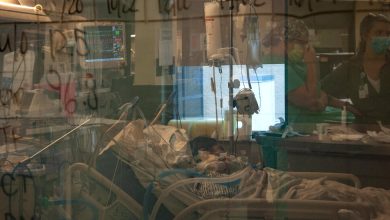When Will the Omicron Surge Peak in California?


Covid-19 testing in Gardena.Credit…Allison Zaucha for The New York Times
Over the past week or so, new coronavirus infections have begun to fall in parts of the United States where the Omicron variant first proliferated: Chicago, Cleveland, New York, Washington, D.C.
California, hopefully, won’t be far behind.
Based on what we know from other countries hit by Omicron, a steep rise in new cases typically lasts one month and then begins to plummet, as my colleague David Leonhardt recently explained.
Outbreaks of the Delta variant, by contrast, typically led to two months of rising cases.
In New York State, the Omicron surge began its sharp ascent in early December and appears to have peaked on Jan. 9, according to The New York Times’s coronavirus tracker.
In California, the Omicron-fueled rise in cases started later, in mid-December. The state is now reporting a staggering 119,000 new cases per day, many times greater than the previous high.
But if our Omicron surge plays out the way it has elsewhere, infections should begin to drop here by the end of the week. A model from the University of Washington’s Institute for Health Metrics and Evaluation predicts that new cases in California will crest by midweek.
Already, wastewater samples in parts of the Bay Area, including Silicon Valley, Sacramento and San Francisco, show a decline in the presence of the coronavirus over the past 10 days, as reported by The San Francisco Chronicle.
Coronavirus levels in sewage are often an early indicator of emerging trends. The virus can be detected in wastewater before an infected person develops symptoms, gets tested or is counted as a positive case.
“You’re starting to see not just parts of the globe — South Africa and the U.K. — but even parts of this country where we’re starting to see in the last three or four days some case leveling,” Gov. Gavin Newsom said at a news conference last week. “That’s going to happen here in the state of California as well.”
The Times’s coronavirus tracker shows what appears to be a plateau in cases in California over the past week, but it’s too early to draw clear conclusions. There may also be delays in reporting because of the holiday weekend.
Even under the hopeful scenario that the spread of Omicron slows this week in California, the surge is far from over. Peaking would mean we have reached the halfway point.
There will be as many new infections on the way down as they there were on the way up, Dr. Ashish K. Jha, dean of the Brown University School of Public Health, said on Twitter on Sunday. He also said that he believed California’s Omicron surge was flattening.
Jha and others warn that it will be many weeks before we’re able to reduce the strain on our health care system. Because it usually takes several days for an infected person to become ill enough to require hospitalization, the number of people in California hospitals will increase for weeks.
Currently, about 14,000 people are hospitalized with Covid-19 across California, according to state data.
But state officials predict that our hospitalization numbers will peak at the end of the month, with almost 30,000 people admitted with Covid-19, more than ever before.
The latest on Omicron and the pandemic
-
Some colleges are loosening rules for a virus that won’t go away.
-
There’s a new effort to fight vaccine hesitancy among Native Americans, The Associated Press reports.
-
California hospitals find that Omicron causes fewer hospitalizations and shorter stays.
-
Omicron has forced the C.D.C. to make tough decisions with scant data.
-
Check case rates in your area.
The rest of the news
-
Solar energy: Former Gov. Arnold Schwarzenegger weighs in on a state proposal to charge solar energy customers: “It should be stopped in its tracks,” he writes.
-
Marianne Williamson: The former presidential candidate has never been easy to categorize. Here’s what’s next for her.
SOUTHERN CALIFORNIA
-
Journalist dies: Michael Parks, a Pulitzer Prize-winning journalist who became the top editor at The Los Angeles Times, died on Jan 8. in Pasadena. He was 78.
-
Custom 1951 mercury: A custom 1951 Hirohata Merc, a classic example of the custom car scene in Southern California during that era, sold for $1.95 million over the weekend.
-
Pasadena car crash: Three teenagers were killed in a car crash in Pasadena after the car they were in hit a curb and tumbled over an embankment, The Associated Press reports.
CENTRAL CALIFORNIA
-
Jan. 6 interview: Kevin McCarthy, the House Republican leader who represents the San Joaquin Valley, said he would refuse to cooperate with a panel investigating the attack on the Capitol.
NORTHERN CALIFORNIA
-
Crow conundrum: Residents and city officials of Sunnyvale are hoping that lasers can combat an overpopulation of crows.
-
Animals removed from home: Sheriff’s deputies found 61 animals — including a dead horse — living in unfit conditions in Yuba County, The Associated Press reports.
What you get
$3.2 million homes in California.
What we’re eating
How to cook salmon.
Where we’re traveling
Santa Cruz County made The Times’s list of 52 places to visit this year:
Tell us about your favorite places to visit in California. Email your suggestions to [email protected]. We’ll be sharing more in upcoming editions of the newsletter.
Tell us
Health workers: How are you coping with Omicron?
And before you go, some good news
Today I’m ending with news about a different virus, one that is helping to protect California’s beloved abalone.
For millenniums, the Golden State’s coastline has been home to some of the richest abalone diversity in the world.
But the numbers of these giant sea snails began to shrink in the 1980s as a bacteria infected their digestive lining and made it nearly impossible for them to absorb food.
The state’s abalone population was already suffering from years of overfishing, and the new threat only made the problem worse.
But then about 15 years ago, scientists noticed that something was happening to the bacteria. A virus had started to eat them, making it easier for the abalone to thrive.
“There are some viruses that are good,” Steffanie Strathdee, co-director of the Center for Innovative Phage Applications and Therapeutics at the U.C. San Diego School of Medicine, told The Mercury News. “You know, sometimes the enemy of my enemy is my friend.”
Thanks for reading. I’ll be back tomorrow. — Soumya
P.S. Here’s today’s Mini Crossword, and a clue: Human organ with the ability to regenerate itself (5 letters).
Jonah Candelario and Mariel Wamsley contributed to California Today. You can reach the team at [email protected].
.





